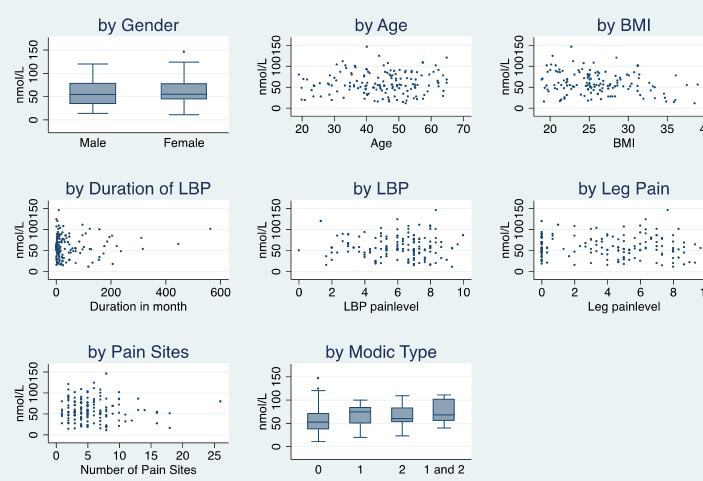Back pain associated with less than 40 ng vitamin D
Vitamin D levels appear to be normal in Danish patients attending secondary care for low back pain and a weak positive correlation between serum level Vitamin D and Modic changes was demonstrated: a cross-sectional cohort study of consecutive patients with non-specific low back pain
BMC Musculoskeletal Disorders, Volume 14, March 2013
Jannick Vaaben Johansen, Claus Manniche and Per Kjaer
Background:Hypovitaminosis D has previously been reported in both the general population, in people with chronic musculoskeletal pain, and in people with low back pain (LBP). Myopathy-related symptoms such as diffuse bone and muscle pain, weakness and paresthesia in the legs, have also been observed in people with non-specific LBP and associations with low levels of Vitamin D have been suggested. The objectives of this study were to investigate (1) Vitamin D levels in patients seeking care for LBP in a Danish out-patient secondary care setting, and (2) their possible relationship with myopathy-related symptoms, Body Mass Index (BMI), and Modic changes.
Methods: A total of 152 consecutive patients with non-specific LBP participated in a cross-sectional study. Participants were recruited at The Spine Centre of Southern Denmark during springtime 2011. Individual serum levels of 25-Hydroxyvitamin-D were determined using Liquid Chromatography Tandem Mass Spectrometry (LC-MS/MS). Information about symptoms, height, and weight were collected from electronic questionnaires completed by the participants. All patients had an MRI from which Modic changes were identified. Correlations between Vitamin D level and pain, paresthesia, weakness in the legs, BMI or Modic changes were described using correlation coefficients and odds ratios obtained from logistic regression.
Results:Two-thirds of the included patients with LBP had normal Vitamin D levels of >50 nmol/L.
No correlations were seen between Vitamin D deficiency and gender, age, back pain intensity, leg pain intensity, and duration of pain.
Statistically significant, but low, correlation coefficients were found between Vitamin D levels and BMI as well as Modic changes.
Low Vitamin D levels and Modic changes were statistically significantly associated with an odds ratio of 0.30 (95% CI 0.12;0.75) while weakness, paresthesia and widespread pain were not.
Conclusions: In patients seeking care for low back pain in a Danish outpatient clinic, Vitamin D deficiency was not common.
Whether patients who are overweight or who have Modic changes might represent subgroups of people for whom their LBP may be associated with Vitamin D levels, needs further investigation.


Provisional PDF is attached at the bottom of this page
See also VitaminDWiki
Back pain reduced for 95 percent of those who took vitamin D - 2003 PDF file
- 5,000 - 10,000 IU vitamin D3 intervention
Vitamin D reduced skeletal pain in 85 percent of the patients – Nov 2012
See also web
- Modic Changes Wikipedia
- Modic changes can only be seen on a magnetic resonance imaging, an MRI.
- Modic changes were first described and separated into 3 different types of changes by Dr. Michael Modic in 1988.
- Studies have shown that patients with Modic changes are rather different from other patients with normal back pain. For example 75 –80 % of patients suffering from Modic changes have constant pain, which means they do not ever have a pain-free moment day or night. There might be fluctuations in the intensity, but no break from the pain. 75% of the patients also suffers from pain during the night, and many wake up during the night because it is painful to turn in bed.
- Overweight/obesity and vitamin D deficiency contribute to the global burden of low back pain
- April 2014 no abstract, PDF costs $35
